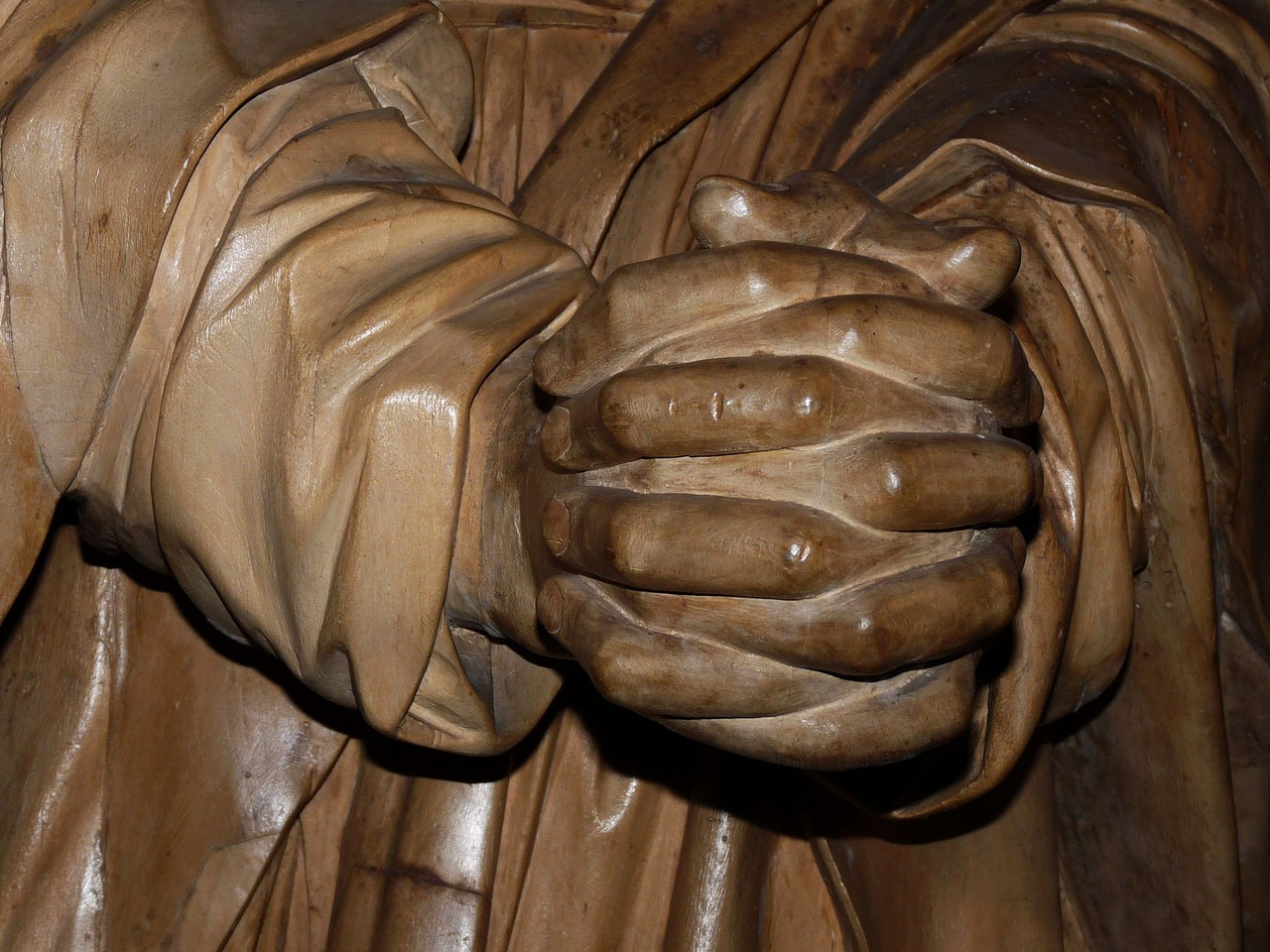A lot of people, whether they are raised in the church or not, are familiar with or aware of the Lord’s Prayer. But what is it really? And what can it teach us about how to pray as Jesus prayed?
In this series, we will explore the Lord’s Prayer phrase by phrase. We will consider what each petition means and think about how to apply it to our own lives. We believe that prayer is a powerful tool for shaping how we think about God, ourselves, the world, and our role in the world. The Lord’s Prayer not only teaches us how to pray like Jesus by giving us words to say, but it also leads us into a rich and meaningful way of talking to and hearing from the Lord.
Stephanie: As a young child, I remember my mom sitting on my bed teaching me the Lord’s Prayer. She was raised Catholic, and while we weren’t regular church attenders, she felt like it was important for me to know that prayer. We also prayed some classic bedtime prayers like, “Now I lay me down to sleep.” But I didn’t really understand prayer. And I didn’t really understand the Lord’s Prayer. When I started going to a Protestant church in high school, they also prayed the Lord’s Prayer, and so it became part of my weekly routine at church: songs, sermon, Lord’s Prayer, songs.
Terry: Unlike Stephanie’s childhood experience, I don’t recall my parents ever praying with me individually—no bedtime prayers, and not even an encouragement to say our prayers at bedtime. We always participated in the life of the church, and we regularly bowed for prayer before our evening meal, usually with a rote, “Lord, bless this food, for Jesus’s sake. Amen.” Before Sunday dinner, one of us might say the Lord’s Prayer, but otherwise my parents never prayed out loud in front of us. Prayer was expected, but not modeled in an audible way.
What is prayer?
Prayer is our way of talking to and communing with God. There are many different ways we approach God in prayer, but at its core, prayer is our ongoing conversation with God.
We can pray in adoration, praising God’s goodness. We can pray in thanksgiving, expressing our gratitude for the ways that God has provided for us. We pray in confession, naming before God our shortcomings and asking to be forgiven for the things we have done wrong. We pray in lament when we cry out to God in frustration, sadness, or pain. We pray in supplication when we come to God with our requests and yearnings, asking for things we need or desire. We pray in silence when we sit quietly, waiting for God to respond in some way, simply being in God’s presence.
We do all of these things as we relate to God. Prayer is not primarily about getting what we want. Prayer is about being transformed by relationship with God, becoming who God wants us to be. Ultimately, prayer is not about a search for things, but it is for communion with God.
What is the Lord’s Prayer?
The Lord’s Prayer is the prayer that Jesus taught when the disciples asked, “How should we pray?” In the Gospel of Matthew, Jesus does a great deal of teaching on how to live in a section called the Beatitudes. The question about how to pray comes just after that (Matthew 6:5-15), and is Jesus’s model for how we should pray. However, Jesus was not teaching us exact words to pray—although we often do pray these words—but giving us a model for prayer.
In the Lord’s Prayer, Jesus teaches us to pray for the things that we need. “Give us this day our daily bread. Forgive our sins. Save us.” Jesus also teaches us to pray for God’s ways above our own. “Your kingdom come, your will be done.” And Jesus teaches us to praise God in prayer. “Hallowed (holy) be your name. The kingdom, the power, and the glory are yours.”
What Jesus does not teach us to do is to go on and on, making ourselves look pious and impressive in the public eye because of the way we pray. In fact, Jesus says in Matthew 6, “Do not heap up empty phrases.” There is no reason for us to pile on big theological words, or flowery phrases, in order to impress others. God is not impressed by our fancy words, but by the sincerity of our prayers.
You may have noticed that different churches use different versions of the Lord’s Prayer. Sometimes you’ll hear a very formal version that uses “Thy,” and other times you’ll hear “Your.” Some churches prefer “trespasses” when asking for forgiveness, while others use “debts” or “sins.” The exact words that we use when we pray the Lord’s Prayer are mostly about preferred translation.
In North America, most of us aren’t praying in the original biblical language, and so it’s safe to choose the translation that informs and speaks to your heart. For this series, we’ve chosen to use a translation that is more modern in its language because that is the most understandable to us. If you prefer to say “Thy” and “trespasses,” rather than “Your” and “sins,” go for it!
The Lord’s Prayer as a teaching tool
The church today often uses the Lord’s Prayer as a scripted set of words that we pray together, communally or corporately. The Lord’s Prayer separates us from the tendency to focus on ourselves and assumes that we are praying with and for others. Have you ever noticed how much “us” language is in the Lord’s Prayer? There are no individual requests in the Lord’s Prayer. Everything is communal. The plural “our” and “us” reminds us that we are not alone or isolated but are interdependent and responsible to one another. Whether we are praying with a congregation or alone, we are united with God’s people everywhere. Praying the Lord’s Prayer in a group setting makes that reality even more tangible.
And while it is a good practice to engage in ritual and corporate prayers that shape the way we worship, the Lord’s Prayer was not meant to be relegated to recitation on a Sunday morning. The Lord’s Prayer teaches us individually how we ought to pray, and can be used as a meditation or an outline for personal prayer time. The Lord’s Prayer takes us through many movements, or types, of prayer. If we spend time thinking about the different ways in which we pray, the Lord’s Prayer will help us to engage with praise, supplication (or requests), confession, and assurance.
When praying the Lord’s Prayer individually, consider taking time to go slowly and ponder each line, each petition. How are you speaking to God in that phrase? How does that petition apply to you personally? How does that petition apply to humanity, corporately? For example, what sins do you personally need to confess, and what sins do we need to confess as a society?
We should also consider the impact of the Lord’s Prayer on the way we live. If we are asking God to “give us this day our daily bread,” we may need to examine our participation in a culture trained to consume and seek our own desires for pleasure. We should wonder how we can be used by God to ensure that others have their daily bread as well. We need to thank God for the “daily bread” that has already been provided and challenge ourselves to be content with enough, rather than constantly searching for more.
The example of Jesus praying
In the New Testament, Jesus teaches the disciples how to pray by giving them the Lord’s Prayer, but he also shows the importance of prayer by the way he actively incorporates prayer into his life.
Jesus prays with and for people. Jesus retreats for private prayer. Jesus prays at tables, prays for those who are sick, prays for the future of God’s people, and even prays for God to remove the burden of the cross from him. Jesus prayed consistently, in all kinds of ways, and always focused on glorifying God.
The Lord’s Prayer is not the only prayer we find Jesus praying in the Bible. Jesus did not restrict himself, or us, only to praying the exact words of the Lord’s Prayer. It is, as many pastors say, “the prayer Jesus taught us,” and we can use that prayer to help us learn how to pray and how to grow in our ability to pray. By taking our time, meditating on the lines of the prayer, and asking God to speak to us, the Lord’s Prayer can be a powerful tool for shaping us into people who more and more reflect the love and life of Jesus in this world.

Stephanie Soderstrom
Stephanie Soderstrom is coordinator for Short-term Mission for the Reformed Church in America. You can connect with her by email at ssoderstrom@rca.org.

Terry DeYoung
Terry A. DeYoung served as coordinator for disability concerns for the Reformed Church in America for 13 years before his retirement in 2023. His wife, Cindi Veldheer DeYoung, is a former hospital chaplain who lives with significant hearing loss. They live in Holland, Michigan, with their lively Brittany Spaniel, Dexter. Among other things, they enjoy traveling, boating, baseball, craft beer, and all things Chicago.



